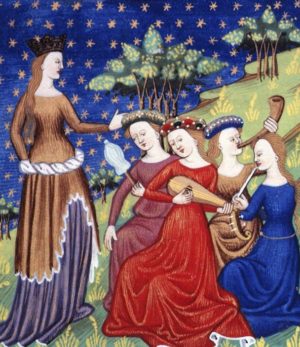In 2018, I recorded one of my favorite podcasts to date: Female Troubadours. In honor of our 2018 Heroines Quilt, which focused on girls in the Medieval and Renaissance, I was able to listen to recordings of actual troubadour music produced by women, read their incredible poems, and uncover how women influenced what we traditionally see as a male-only occupation.

I was introduced to the female troubadours in the book, The Women Troubadours by Meg Bogin. Like many others, I thought that troubadours were only men, and was delightfully surprised to find out about the trobairitz through Meg’s work, which was the first full-length book on the subject. It now sits in a place of honor on my bookshelf.
The troubadours and trobairitz were medieval singer-poets who typically hailed from the south of France. They flourished during the twelfth and thirteenth centuries, thought only a handful of their works – which include poems and dialogues set to music – have been translated and study. The only study of female troubadours prior to Meg’s work dates to 1888.
The troubadours were among the first to express what we know as “romantic love” – a love and affinity that is distinct from sexual passion. As Meg recounts, to the troubadours, “Love was proclaimed the supreme experience of life, and the quest for love, with the lady as its guiding spirit, became the major theme of Western literature” due to their influence. Most of the poems written by troubadours were addressed to women of the high nobility – for example, a queen, duchess, or lady. Often, the troubadour was in pursuit of the lady. These poems talked about the troubadour’s quest for his lady’s love and admiration. In exchange, he pledge his eternal loyalty and obedience to her.
Troubadour poetry was also one of the first times that a vernacular – or common – language was given equal status to literary languages. The movement as a whole spurred the development of poetry in other common languages, and had a profound influence on Western relationships and thought even into the present day.
Yet the troubadour movement – with its emphasis on women holding the reigns of power in relationships and patronage – was in direct contrast to women’s real-life status. Most medieval women were the property and pawns of men, seen only as wives, keepers of the household, and breeders of sons. Their success in life was wholly measured on the fulfillment of their role as wife and mother. It was a time of misogyny on a widespread, and almost institutionalized, scale. Troubadour idolatry gave ladies of the high nobility even more power than they already held by law and custom. This could have spurred the trobairitz to start their own practice, taking the power troubadours had given them in order to finally express themselves as women publicly and in a manner that is almost a response to the men who claim to adore them. It was a way for women to express their desires and needs in a socially acceptable performance.
It is one of the first times we have female witnesses from the medieval period who tell us their stories in their own voices. There are very few sources directly from women otherwise, and the subject matter of the trobairitz is very distinct from their male counterparts. They are exceptional in musical history as the first known female composers of Western secular music – all earlier known female composers wrote sacred music – and exceptional in history itself as being female voices completely unedited by male hands.
Of all the troubadours, we know that about twenty were women, and all of them hailed from the south of France in a region known as Occitania. They were all from the high nobility, wives or daughters of the lords of Occitania, and likely knew male troubadours as family members, friends, or members of their courts. Even more so, at least a third of the trobaritz were patrons of troubadours themselves.
Even more curiouser than the fact there were trobairitz is the subject matter they addressed. The trobaritz wrote about love, but in very different terms from their male counterparts. They often preferred the more straight-forward speech of conversation (as opposed to rhyming) and wrote about relationships that we recognize almost immediately.
Despite their variety, all the trobaritz wrote about two things: first, to be acknowledged for who they are as women and as individuals, and second, to have a determining voice in their lives and relationships. As Meg Bogin stated, “The voices of the women troubadours are as complicated as the voices of real people, and as earth-bound. They sound like women any of us could know. Unlike the men, who often wrote in the persona of the knight, the women wrote in no one’s character but their own.”
Unfortunately, the troubadours and trobaritz did not last long. In 1209, Pope Innocent III proclaimed a crusade against the “heretics” of Occitania, known as the Albigensian Crusade, which targeted the troubadours and their courts of love. Within fifty years, the great cities and centers of the troubadour movement lied in ruins. Women had lost their rights – both in poems and songs as well as law and custom – and fell into a status more in line with the rest of European women of the time. Troubadour poetry, the ultimate symbol of the southern French way of life, had been the first casualty – the troubadours were forced into silence or exile, and the women they so adored had been silenced forever.
It is only through the work of scholars like Meg Bogin, and other medievalists, that we know the trobaritz lived, loved, and – ultimately – sought a better world for women much the same as we do today.
For more on individual trobaritz, and to hear their incredible songs and poems, listen to our GirlSpeak podcast on Female Troubadors.
-Tiffany Rhoades, Program Developer
